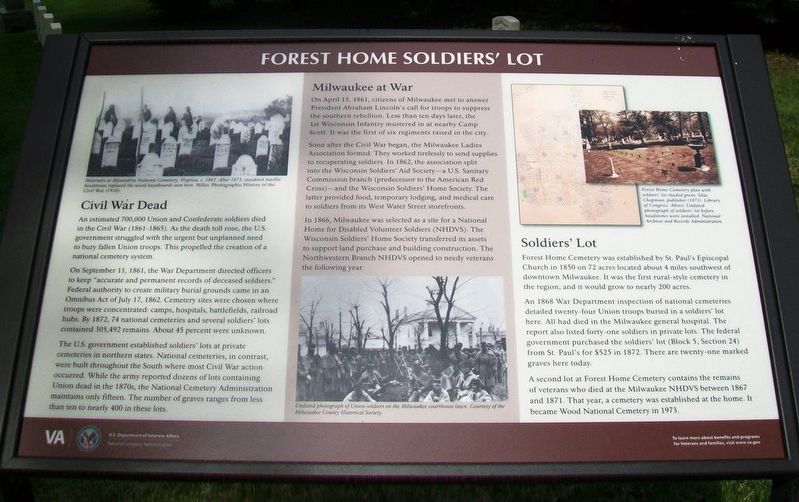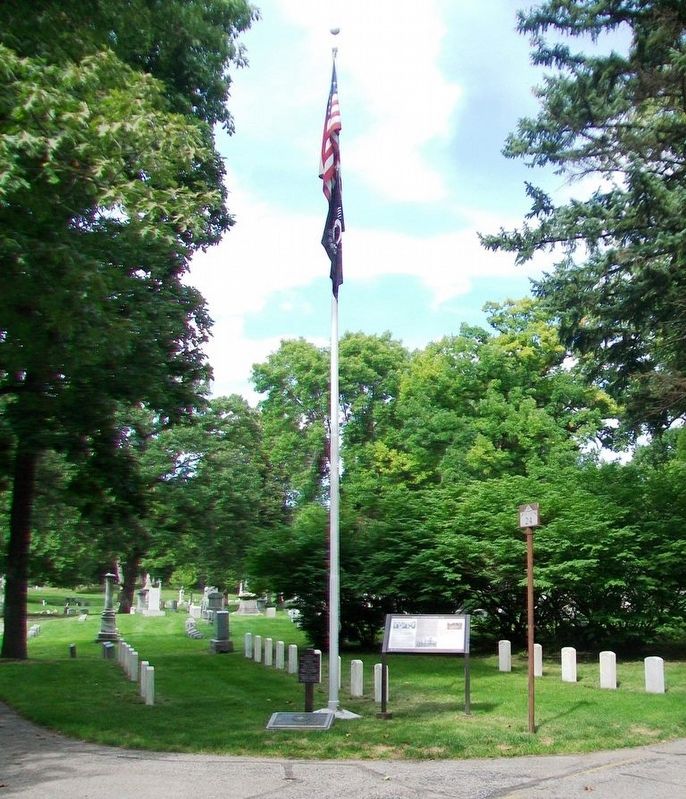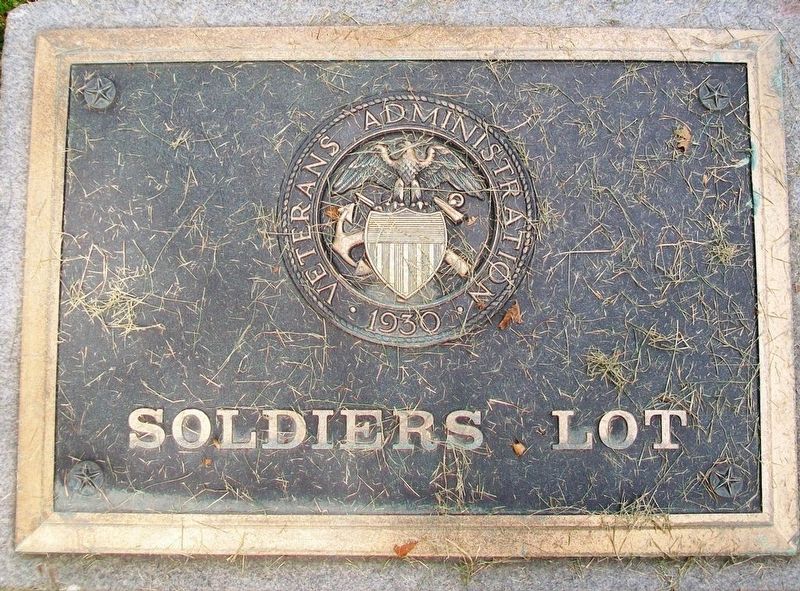Forest Home Hills in Milwaukee in Milwaukee County, Wisconsin — The American Midwest (Great Lakes)
Forest Home Soldiers' Lot
Civil War Dead
An estimated 700,000 Union and Confederate soldiers died in the Civil War (1861-1865). As the death toll rose, the U.S. government struggled with the urgent but unplanned need to bury fallen Union troops. This propelled the creation of a national cemetery system.
On September 11, 1861, the War Department directed officers to keep "accurate and permanent records of deceased soldiers." Federal authority to create military burial grounds came in an Omnibus Act of July 17, 1862. Cemetery sites were chosen where troops were concentrated: camps, hospitals, battlefields, railroad hubs. By 1872, 74 national cemeteries and several soldiers' lots contained 305,492 remains. About 45 percent were unknown.
The U.S. government established soldiers' lots at private cemeteries in northern states. National cemeteries, in contrast, were built throughout the South where most Civil War action occurred. While the army reported dozens of lots containing Union dead in the 1870s, the National Cemetery Administration maintains only fifteen. The number of graves ranges from less than ten to nearly 400 in these lots.
Milwaukee at War
On April 15, 1861, citizens of Milwaukee met to answer President Abraham Lincoln's call for troops to suppress the southern rebellion. Less than ten days later, the 1st Wisconsin Infantry mustered in at nearby Camp Scott. It was the first of six regiments raised in the city.
Soon after the Civil War began, the Milwaukee Ladies Association formed. They worked tirelessly to send supplies to recuperating soldiers. In 1862, the association split into the Wisconsin Soldiers' Aid Society—a U.S. Sanitary Commission branch (predecessor to the American Red Cross)—and the Wisconsin Soldiers' Home Society. The latter provided food, temporary lodging, and medical care to soldiers from its West Water Street storefronts.
In 1866, Milwaukee was selected as a site for the National Home for Disabled Volunteer Soldiers (NHDVS). The Wisconsin Soldiers' Home Society transferred its assets to support land purchase and building construction. The Northwestern Branch NHDVS opened to needy veterans the following year.
Soldiers' Lot
Forest Home Cemetery was established by St. Paul's Episcopal Church in 1850 on 72 acres located about 4 miles southwest of downtown Milwaukee. It was the first rural-style cemetery in the region, and it would grow to nearly 200 acres.
An 1868 War Department inspection of national cemeteries detailed twenty-four Union troops buried in a soldiers' lot here. All had died in the Milwaukee general hospital. The report also listed forty-one soldiers in private lots. The federal government purchased the soldiers' lot (Block 5, Section 24) from St. Paul's for $525 in 1872. There are twenty-one marked graves here today.
A second lot at Forest Home Cemetery contains the remains of veterans who died at the Milwaukee NHDVS between 1867 and 1871. That year, a cemetery was established at the home. It became Wood National Cemetery in 1973.
[Photo captions read]
Mourners at Alexandria National Cemetery, Virginia, c. 1865. After 1873, standard marble headstones replaced the wood headstones seen here. Miller, Photographic History of the Civil War (1910).
Undated photograph of Union soldiers on the Milwaukee courthouse lawn. Courtesy of the Milwaukee County Historical Society.
Forest Home Cemetery plan with soldiers' lot shaded green. Silas Chapman, publisher (1871). Library of Congress. Above: Undated photograph of soldiers' lot before headstones were installed. National Archives and Records Administration.
Erected by National Cemetery Administration.
Topics and series. This memorial is listed in these topic lists: Cemeteries & Burial Sites • Patriots & Patriotism • War, US Civil. In addition, it is included in the National Cemeteries series list. A significant historical date for this entry is April 15, 1861.
Location. 42° 59.839′ N, 87° 56.813′ W. Marker is in Milwaukee, Wisconsin, in Milwaukee County. It is in Forest Home Hills. Monument is at the southwest corner of Section 24 in Forest Home Cemetery. Touch for map. Marker is at or near this postal address: 2405 West Forest Home Avenue, Milwaukee WI 53215, United States of America. Touch for directions.
Other nearby markers. At least 8 other markers are within walking distance of this marker. Byron Kilbourn (within shouting distance of this marker); Edward George Ryan (about 500 feet away, measured in a direct line); In memory of Franklin Van Valkenburgh (about 600 feet away); Orville Cadwell (approx. 0.2 miles away); Mathias Stein (approx. ¼ mile away); Jacob Best (approx. ¼ mile away); Frank N. Fox (approx. ¼ mile away); Dr. Silas J. Sawyer and Jennie E. Sawyer (approx. 0.3 miles away). Touch for a list and map of all markers in Milwaukee.
Also see . . . National Cemetery Administration Fact Sheets. (Submitted on October 8, 2016, by William Fischer, Jr. of Scranton, Pennsylvania.)
Credits. This page was last revised on February 16, 2023. It was originally submitted on October 8, 2016, by William Fischer, Jr. of Scranton, Pennsylvania. This page has been viewed 363 times since then and 9 times this year. Photos: 1, 2, 3. submitted on October 8, 2016, by William Fischer, Jr. of Scranton, Pennsylvania.


